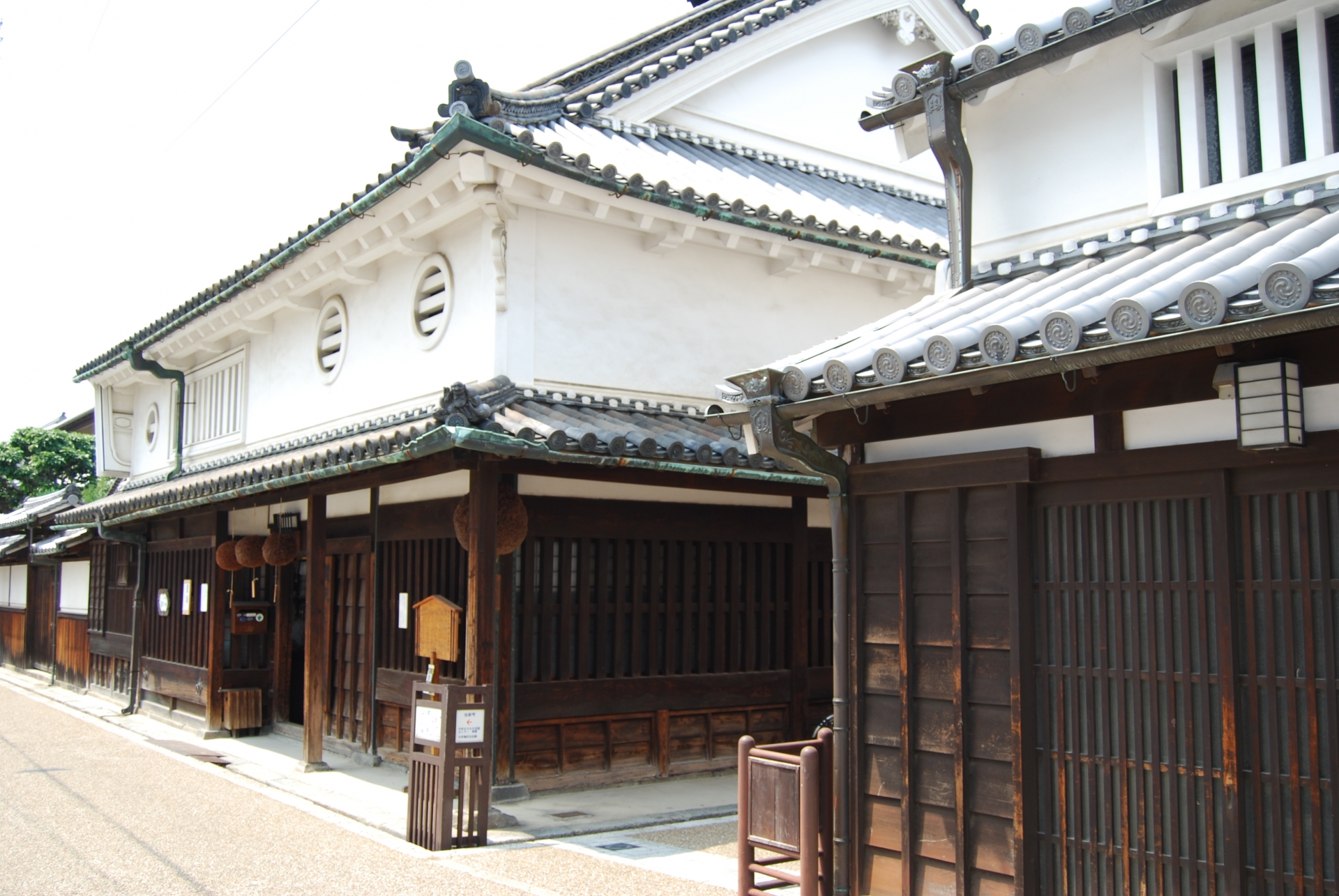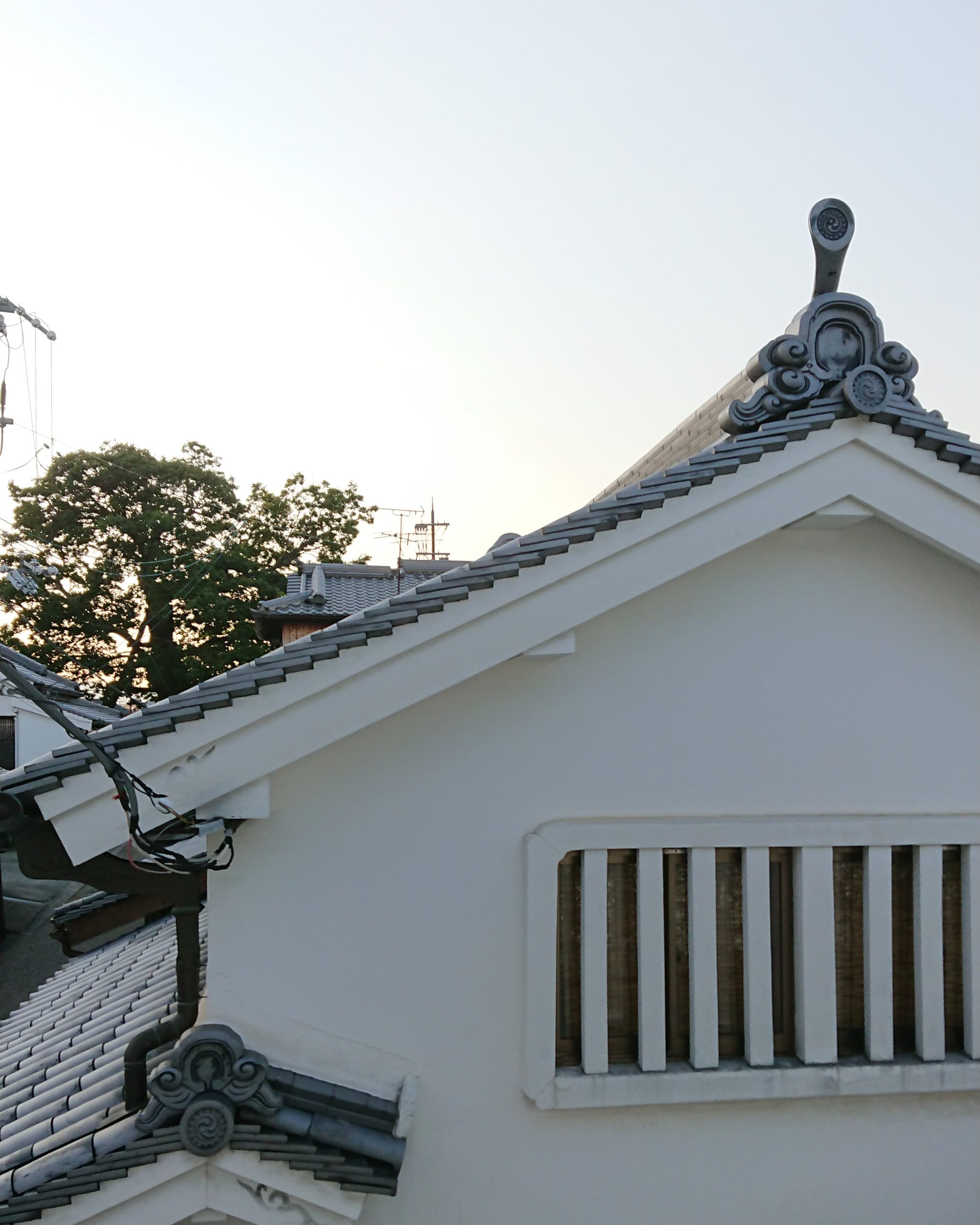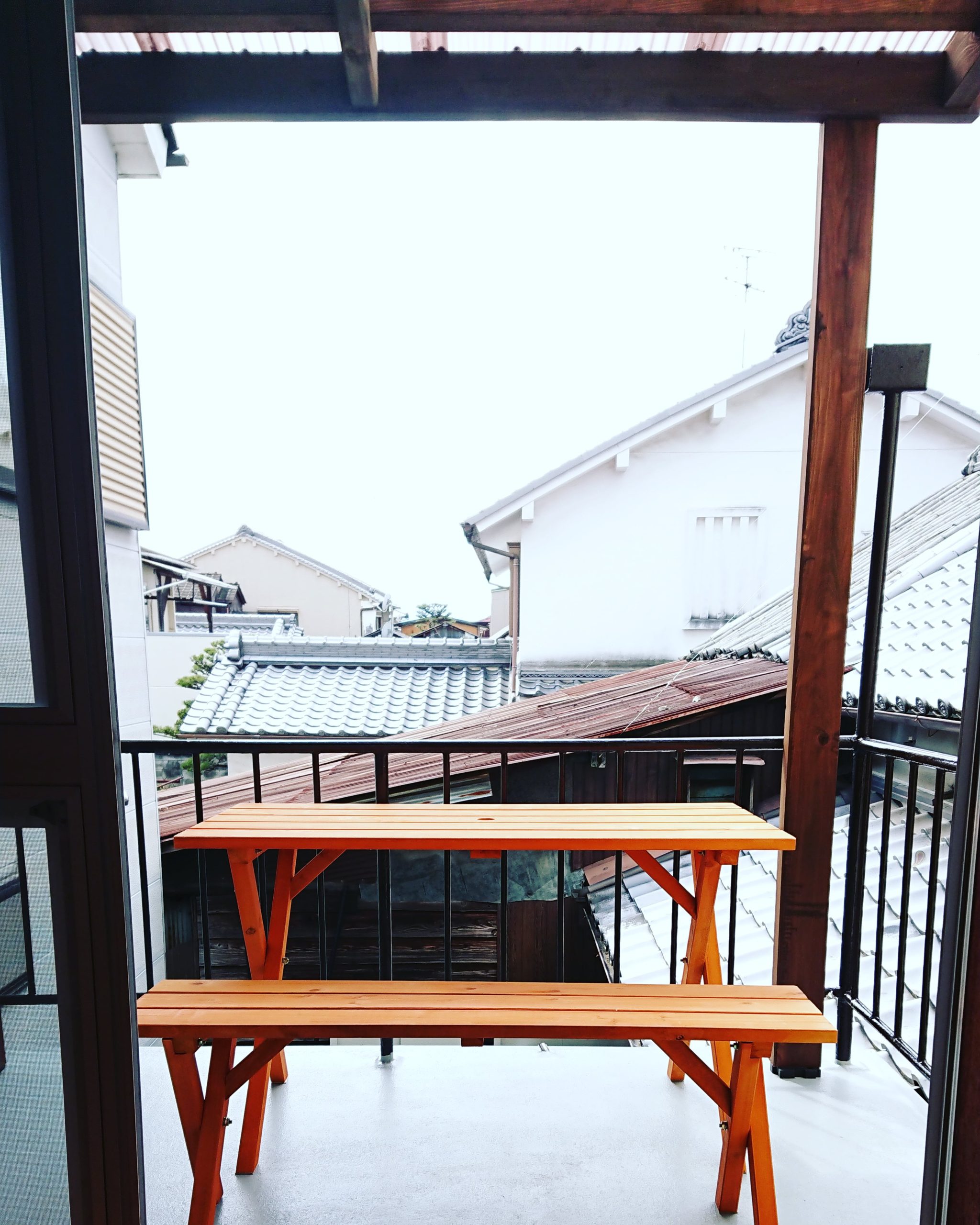ももやの想い

※English follows.
江戸時代が奇跡的に“真空パック”された重要伝統的建造物群保存地区(略称:重伝建保存地区)である「今井町」に、奇跡の景観を有する“見晴らし茶屋” 「ももや」が誕生しました。
茶頭・今井宗久を輩出し、秀吉を”茶屋”でもてなした今井町。まずは、昭和40年代前半の築60年近い”古家”の2階ゆえ、江戸時代では味わえなかった今井町の景色を鳥瞰(ちょうかん)し、町の概観をつかみしましょう!

今から500年近く前、1533年の室町時代中期に宗教武装自治地区である寺内町として今井町は誕生しました。17世紀後半、五代将軍綱吉の幕藩体制以降 、今井町は、「海の堺、陸の今井」「大和の金は今井に七分」と呼ばれる程の栄華を誇り、幕府直轄の天領にもなりましたが、その歴史は堺とは非常に深い繋がりがありました。
それ以前の「応仁の乱」時は京都が混乱し、後に織田信長が登場するまで乱世の時代に突入しました。ちょうどその時期、堺は貿易港として莫大な物資が集まると同時に、文化的にも情報発信拠点としての役割を担うことになりました。今井町の歴史は、実際信長とも戦っていますが、この時代に大きく動きます。
当地今井町出身の今井宗久(1520~1593年)は信長・秀吉に仕え、戦国時代の堺の豪商としても名を馳せていますが、千利休、津田宗及と共に「天下三宗匠」として知られ、茶人として極めて大きな存在でした。
現在、堺の仁徳天皇陵がある大仙公園の敷地内に「黄梅庵」という茶室がありますが、この茶室は実は宗久にゆかりのある茶室でした。もともと今井町の豊田家には江戸時代中期頃の茶室がありましたが、昭和55年(1980年)に堺市に寄贈されました。今井町の記録によれば、豊臣秀吉が今井町を訪れた吉野山の桜花見の際に設けられた茶室であり、「宗久茶屋」と呼ばれていました。現在では毎年5月に行われ、「ももや」の前の北尊坊通りを闊歩する「茶人行列」に引き継がれていますが、そのようなお茶とは切っても切れない土地柄に、見晴らし茶屋「ももや」は誕生しました。
令和2年4月に誕生した「ももや」は、外観こそ「重伝建地区」内の”歴史的建造物”でなく、昭和40年代前半に新築となった”古家”ですが、内部を地元吉野の杉やヒノキ、けやき等の天然無垢材をふんだんに使用し、半年かけてリノベーションした大和の建造物です。
江戸時代・明治時代の天井が低い「厨子(つし)二階」で、さらに視野が狭く窮屈だった「虫籠(むしこ)窓」(上の写真中央)では味わえなかった、つまり過去の時代では経験できなかった景観を昭和の家ゆえ透明感ある大きな4つの窓やベランダから楽しめることに、その特徴があります。
特に、夕陽が沈む頃の西向きのバルコニーからは二上山方面の街並みが楽しめるロケーションは稀有です。その景観は、時間が止まったままで、ほぼこの200年間は変わっていないでしょう。

また、最寄りの近鉄橿原線急行停車駅の「八木西口」から徒歩3分(特急停車駅「大和八木」駅から徒歩10分)と駅から近い東北角地に面した高みにあることが、今井町の魅力をワンストップ、オールインワンで“見晴らせる”ことを可能にしました。海外からも、関空から定期バスで「大和八木」駅までわずか1時間と便利で、唯一無二な立地であります。これは、「百聞は一見に如かず」で、訪れるとおわかりいただけると思います。
もちろん、魅力は景観や好立地だけにとどまりません。1958 年(昭和 33 年)には、奈良県産の「べにほまれ」で作った紅茶が、ロンドンの全世界紅茶品評会で最優秀賞を獲得し、国内だけでなく世界からも高い評価を受けた伝統ある大和の「和紅茶」や、いちじくや柿等の「果実葉茶」、そして大和の地で私達が発見した人気の和菓子をセットでお楽しみいただけるカフェであります。
遠く奈良時代に編纂された、『大和国風土記(やまとのくにふどき)』には、)には、「面語(おもがたり)」という言葉が現れます。それは、「 面と向き合って語る」という意味ですが、今井町を通じて、500年という歴史の時間軸の中で、訪問者が自分の成り立ちを見つめられる、自分との接点が共に語れる、そのようなご縁がある“場”、そして再訪時に、「ただいま」といえる気が休まる茶屋にできればと存じます。
令和2年4月吉日
今井町見晴らし茶屋「ももや」亭主
営業時間:当面9時30分から17時まで。
2階席数:15席
営業日:金曜日〜月曜日と祝祭日

【Momoya’s wish】
Momoya was built in Imaicho town where is designated as Important Preservation District for Groups of Traditional Buildings showing townscape reminding Edo era(1603-1868)
Imaicho town is famous for the place where Sokyu Imai was born, a renowned tea master, and Hideyoshi Toyotomi had a tea ceremony. You can enjoy fabulous scene of Imaicho town from the 2nd floor of this fifty-years-old house where have been since 1960s.
Back in 1533, Imaicho town was built as “Jinaicho”, where merchants and masterless samurais gathered to form.
In the late 17 century, which is after the fifth Shogun Tsunayoshi Tokugawa’s feudal system, Imaicho flourished and became popular as commercial and industrial town since it was called that one-seventh gold in the area can be mined from Imaicho and recognized resourced area as same as Sakai which was one of the biggest port city.
Sokyu Imai who was one of the greatest merchants and tea masters from Imaicho town served Nobunaga and Hideyoshi and was known as three tea masters alongside Sen no Rikyū and Tsuda Sōgyū.
Currently there is tea-ceremony room called “Obaian” at Daisen park in Sakai city, and it has a deep connection with Sokyu. Originally, it was owned by Toyoda family in Imaicho town and donated to Sakai city in 1980. According to the record in Imaicho town, it used to be called “Sokyu tea-ceremony room” and was built for Hideyoshi Toyotomi coming to see cherry blossom tree at Mt. Yoshino. In May every year, there is one event inspired by Sokyu and in which people disguise with Kimono and walk through the Imaicho town called “Sajin-Gyoretsu”
Momoya was established in the area where strongly related to tea culture.
As you can read through above, Imaicho is deeply connected with tea culture. Momoya where was built in Apr 2020 is not exactly the historic building in Important Preservation District for Groups of Traditional Buildings but is an old building from 1960s. However the inside of it was renewed with a lot of pollen, Japanese cypress, zelkova and natural wood taking a half of the year to renew.
Before renovation, this building was typical two story building in Edo era and Meiji era which had a fenced window so that people cannot enjoy outside view. But after renovation, people became to enjoy historic scenery from the clear huge window and the balcony which people in Edo era and Meiji era could not.
Especially, it is pretty rare that people can see the townscape in direction of Mt. Nijo where you can see from the balcony facing to the west at sunset. The scenery is fabulous as if time has stopped for 200 years.
It is also easy to access to Momoya since it locates uphill 3 minutes walk from Yaginishiguchi station, 10 minutes walk from Yamatoyagi station though. Imaicho town is one-stop and all-in-one sight where you will literally experience “seeing better than hearing”
You will have great experience at Momoya not only scenery, but tea, which is made of strawberry from Nara prefecture called “Benihomare” and awarded at global tea championship in London, 1958. Also, there is a traditional Japanese tea called “Wa Kocha” which had references from all the world and Fruits tea like fig and persimmon assorted with Japanese sweets.
In the old records called “Yamato No Kuni Fudoki” edited back in Nara era, it mentioned a word called “Omogatari”. It means facing something and address. We hope that all of you can experience that here somehow in Momoya.
Apr 2020
Owner of Momoya
Opening hours : 9:30-17:00
No. of seats : 15
Opening day : Friday,Saturday, Sunday and Monday
※Please confirm opening hours and day each time.
Translated by Yoshiaki Idesaki(出崎 義明)

